
The Michael Faraday Memorial is a monument to the Victorian scientist Michael Faraday. It is located at Elephant Square in Elephant and Castle, London, England.

The Michael Faraday Memorial is a monument to the Victorian scientist Michael Faraday. It is located at Elephant Square in Elephant and Castle, London, England.

The stainless steel box-shaped structure was designed by modern movement architect Rodney Gordon in 1959 and built in 1961, on the centre of what was the northern roundabout of the Elephant and Castle gyratory system. It commemorates Michael Faraday's importance as a scientist and was placed at Elephant and Castle because Faraday's birthplace is nearby in Newington Butts.
The interior of the construction contains a London Underground electrical substation for the Northern line and Bakerloo line (somewhat appropriate for a memorial to one of the great pioneers of electricity). Rodney Gordon originally designed the box clad in glass, intending the workings of the transformer to be seen. The possibility of vandalism prevented this, so the design was changed to a metal casing.
Aspects of Gordon's design which explained the connection to Faraday were left out when it was constructed, so few people realise why it is there. However, there is an inscription in the concrete paving nearby explaining that it is the Faraday Memorial.
In 1996, the monument was given Grade II listed building status.
In 1996, the memorial was given a new lighting scheme designed by a local schoolgirl from English Martyrs R.C primary school, the result of a competition held by Blue Peter, the BBC children's programme.
Plans in the early 2000s to redevelop the Elephant and Castle included turning the roundabout into a peninsula and moving the Michael Faraday Memorial 400 metres south-east to the Walworth Road, where it would stand next to the Cuming Museum and possibly become part of a proposed science museum. These plans were shelved as the regeneration of Elephant and Castle evolved into a scheme that retained the roundabout, before changing into a scheme that retained the memorial in its current position by "peninsulaising" it, in the process making it easier to access. [1]
In May 2012, the 16-year-old lighting scheme (which had long since stopped working) was replaced with a new disco theme [2] by Southwark Council, animating every evening after dark.

Michael Faraday was an English scientist who contributed to the study of electromagnetism and electrochemistry. His main discoveries include the principles underlying electromagnetic induction, diamagnetism and electrolysis. Although Faraday received little formal education, as a self-made man, he was one of the most influential scientists in history. It was by his research on the magnetic field around a conductor carrying a direct current that Faraday established the concept of the electromagnetic field in physics. Faraday also established that magnetism could affect rays of light and that there was an underlying relationship between the two phenomena. He similarly discovered the principles of electromagnetic induction, diamagnetism, and the laws of electrolysis. His inventions of electromagnetic rotary devices formed the foundation of electric motor technology, and it was largely due to his efforts that electricity became practical for use in technology.

In electricity generation, a generator is a device that converts motion-based power or fuel-based power into electric power for use in an external circuit. Sources of mechanical energy include steam turbines, gas turbines, water turbines, internal combustion engines, wind turbines and even hand cranks. The first electromagnetic generator, the Faraday disk, was invented in 1831 by British scientist Michael Faraday. Generators provide nearly all the power for electrical grids.

The London Borough of Southwark in South London forms part of Inner London and is connected by bridges across the River Thames to the City of London and London Borough of Tower Hamlets. It was created in 1965 when three smaller council areas amalgamated under the London Government Act 1963. All districts of the area are within the London postal district. It is governed by Southwark London Borough Council.

Elephant and Castle is an area of South London, England, in the London Borough of Southwark. The name also informally refers to much of Walworth and Newington, due to the proximity of the London Underground station of the same name. The name is derived from a local coaching inn.

New Kent Road is a 1 kilometre (0.6 mi) road in the London Borough of Southwark. The road was created in 1751 when the Turnpike Trust upgraded a local footpath. This was done as part of the general road improvements associated with the creation of Westminster Bridge; in effect it was possible to travel from the West End/ Westminster to the south-east without having to go via the Borough of Southwark but could now cross St George's Fields to the junction of Newington Causeway and Newington Butts which is where New Kent Road starts at Elephant & Castle. The route runs eastward for a few hundred yards to the junction of Great Dover Street and Tower Bridge Road, known as Bricklayers Arms, where it joins the original route to the south-east Old Kent Road.

The Royal Institution of Great Britain is an organisation for scientific education and research, based in the City of Westminster. It was founded in 1799 by the leading British scientists of the age, including Henry Cavendish and its first president, George Finch. Its foundational principles were diffusing the knowledge of, and facilitating the general introduction of useful mechanical inventions and improvements, as well as enhancing the application of science to the common purposes of life.
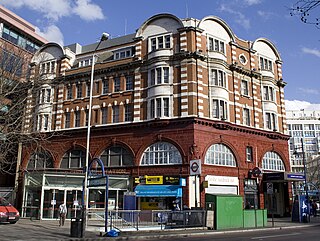
Elephant & Castle is a London Underground station in the London Borough of Southwark in south London. It is on the Bank branch of the Northern line between Kennington and Borough stations, and is the southern terminus of the Bakerloo line, the next station being Lambeth North. The station is in both Travelcard Zones 1 and 2. The Northern line station was opened in 1890 by the City and South London Railway (C&SLR) while the Bakerloo line station was opened sixteen years later by the Baker Street and Waterloo Railway (BS&WR). There is an out-of-station interchange with the nearby Elephant & Castle National Rail station.

Victoria Embankment is part of the Thames Embankment, a road and river-walk along the north bank of the River Thames in London, England. Built in the 1860s, it runs from the Palace of Westminster to Blackfriars Bridge in the City of London, and acts as a major thoroughfare for road traffic between the City of Westminster and the City of London.
The year 1961 in architecture involved some significant architectural events and new buildings.
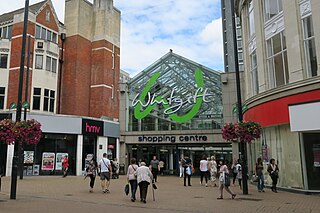
The Whitgift Centre is a large shopping centre in the town centre of Croydon, opening in stages between 1968 and 1970. The centre comprises 1,302,444 sq ft (121,001 m2) of retail space, and was the largest covered shopping development in Greater London until the opening of Westfield London at White City in 2008. The Whitgift Centre has a monthly footfall of 2.08 million. The complex includes an office development.
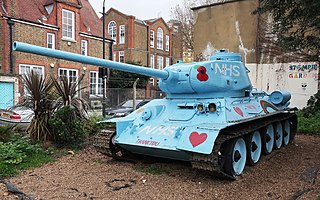
The Mandela Way T-34 Tank, nicknamed Stompie, is a decommissioned Soviet-built T-34-85 medium tank, formerly located on the corner of Mandela Way and Page's Walk in Bermondsey, London, England. The tank was regularly repainted in a wide variety of colour schemes, often by graffiti artists. In January 2022 it was removed for restoration, and its owner stated in April 2023 that it may not return to its former location due to concerns that the graffiti may affect its historical preservation.
Events from the year 1961 in art.
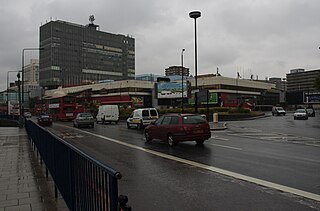
Newington Butts is a former hamlet, now an area of the London Borough of Southwark, London, England, that gives its name to a segment of the A3 road running south-west from the Elephant and Castle junction. The road continues as Kennington Park Road leading to Kennington; a fork right is Kennington Lane, leading to Vauxhall Bridge. Michael Faraday was born in Newington Butts.

Perronet House is an 11-storey residential council tower block adjacent to the northern roundabout of the Elephant and Castle, in London.
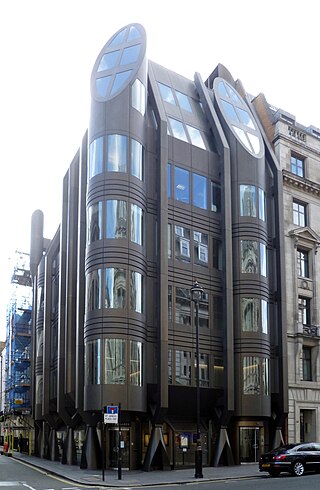
Rodney H Gordon was an English architect. He was the primary architect of the Tricorn Centre, Portsmouth, and Trinity Square, Gateshead. Architecturally, his works were primarily in concrete; he was said to be a Brutalist and his buildings have been described as "dramatic, sculptural and enormous" as well as "futuristic".

The Heygate Estate was a large housing estate in Walworth, Southwark, South London comprising 1,214 homes. The estate was demolished between 2011 and 2014 as part of the urban regeneration of the Elephant & Castle area. Home to more than 3,000 people, it was situated adjacent to Walworth Road and New Kent Road, and immediately east of the Elephant & Castle road intersection. The estate was used extensively as a filming location, due in part to its brutalist architecture.

The United Nations Slavery Memorial, officially known as The Ark of Return – The Permanent Memorial at the United Nations in Honour of the Victims of Slavery and the Transatlantic Slave Trade, is an installation at the Visitors' Plaza of the Headquarters of the United Nations in New York City, intended as a permanent reminder of the long-lasting effects of slavery and the Transatlantic slave trade. It was designed by Rodney Leon, a Haitian-American architect, and installed in 2015.
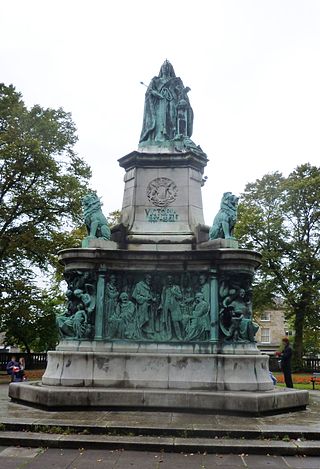
The Queen Victoria Memorial in Lancaster, Lancashire, England, is a Grade II* listed building. It stands in the centre of Dalton Square, Lancaster facing Lancaster Town Hall. It was erected in 1906, being commissioned and paid for by James Williamson, 1st Baron Ashton.

Elephant Square is a public space in Elephant and Castle, London. The square was created by Transport for London (TfL) as part of work to reconfigure the local road layout. By removing the road on the east side of the area's northern roundabout, TfL joined a former traffic island to the site of the Elephant and Castle shopping centre. The new square forms one part of the regeneration programme underway in the district which includes plans for a new town centre.